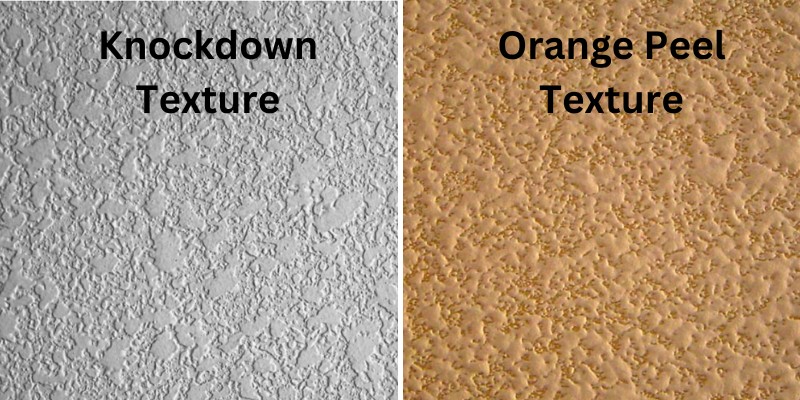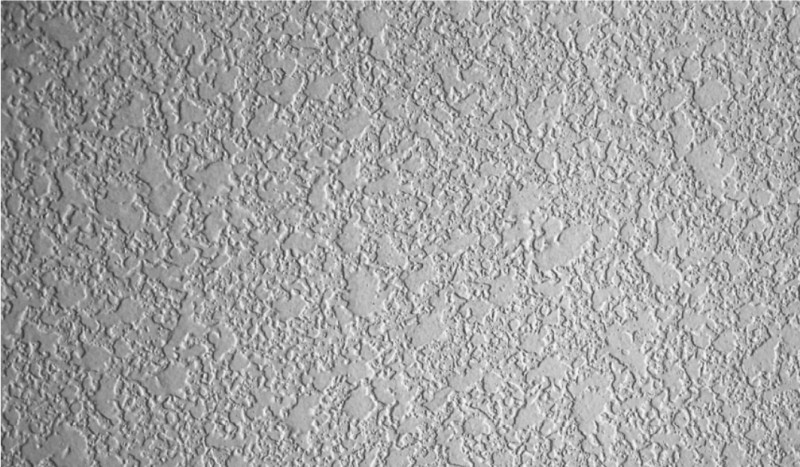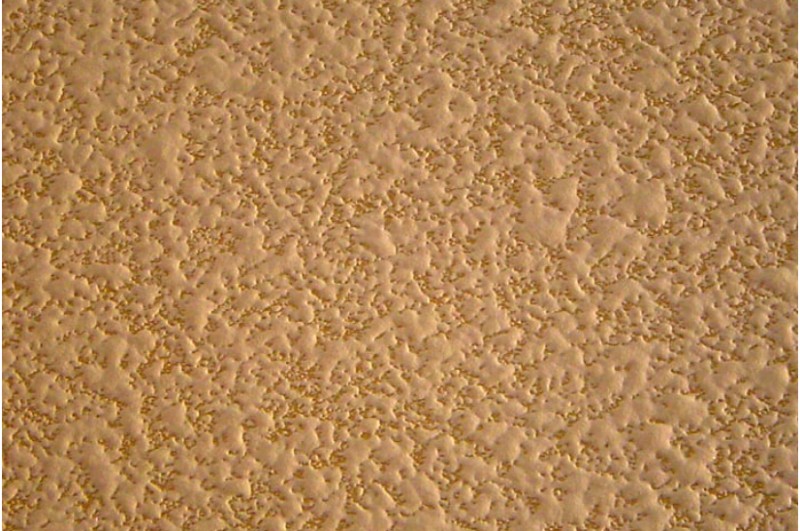Texturing walls can enhance them beautifully! While you can pick from 15 texture styles, knockdown and orange peel are trending now. Plus, they’re a breeze to apply.

Here I compare knockdown and orange peel drywall textures regarding their:
- appearance
- application methods
- durability
- ease of cleaning
- noise reduction
- successful repair
- costs
I also answer questions you likely have. Texturing walls gives them character and flair!
What are the benefits of textured walls?
When you embellish wall surfaces, a room appears larger than it would otherwise. Since drywall textures have a raised finish, you can hide wall imperfections, such as dents, nail holes, and drywall seams.
Flat walls tend to amplify noise since they bounce and deflect sound waves. Conversely, textured walls absorb and muffle sounds, making rooms quieter. Meanwhile, uneven surfaces reflect light, yielding a brighter, uplifting ambiance.
Moreover, finishing a textured wall takes less time and effort than a smooth one. Best of all, texturing enables you to customize your rooms.
Should I take any precautions when using wall texture materials?
Yes, before doing the prep work of sanding a wall, put on a dust mask and goggles. Then, wear a charcoal respirator and goggles when applying the drywall compound. This way, you’ll shield your eyes from the splatter and your lungs from caustic solvents.
Also, protect your floor and furniture with drop cloths.
What is knockdown drywall texture?
A knockdown finish has a mottled appearance similar to stucco. After spraying the compound, you run a drywall taping knife across it, flattening the droplets. Since this technique reduces the height of the coating, it’s called knockdown.

Knockdown Texture
The leveled droplets vary in size, shape, and degree of wall coverage. Due to their casual arrangement, knockdown texture is ideal for modern and contemporary decor. Many homeowners choose this wall accent for their hallways, living rooms, and bedrooms.
Since knockdown texture has a medium density and uneven surface, it helps to mute noise.
Do any of your rooms have hardwood floors? If so, consider using knockdown texture to soften the sounds of foot traffic.
How do you create knockdown texture on a wall?
First, ensure an even wall surface by lightly sanding it smooth. Next, apply a drywall filler. Then, follow the steps below.
- Obtain a hopper, spray gun, drywall compound, and drywall taping knife measuring 12 to 18 inches.
- Ensure cross-ventilation with fans or open windows. Then, put on protective goggles and a charcoal respirator.
- Add water to the drywall powder according to the package directions, stirring well.
- Pour the mixture into the hopper.
- Wait 15 minutes for the water to infiltrate the powder.
- Spray the mixture onto the wall, splattering it to form peaks and dips. Aim for a coverage depth of about 1/8 inch.
- Run the drywall knife across the wall in a smooth motion, flattening the droplets.
- Let the compound cure overnight.
- Seal the wall surface with a primer, followed by painting.
Are there any knockdown application tips?
Yes! Here are three pointers.
Spraying the Compound
If this is your first time texturing a wall, practice spraying a large piece of cardboard. This way, you’ll get familiar with how the spray gun works.
If you don’t have suitable cardboard, use a scrap piece of drywall or a sizeable sheet of paper. Be sure to protect your floor and furniture with drop cloths.
Knockdown Timing
To form a stippled texture, you need the right timing. If you wait too long to reduce the droplets, the compound will dry out. In that case, the drywall knife will etch lines in the wall.
Conversely, if the drywall mixture is too wet, it will smear instead of splattering.
For the best knockdown timing, wait until the drywall mixture starts losing its sheen. Typically, this takes 10 to 15 minutes. If you start the reduction process and lines appear in the drywall, wait a few minutes before resuming.
Then, flatten the droplets in the order of their application.
Using a Drywall Knife
Run the drywall knife lightly across the wall. If you apply heavy pressure, the droplets will merge, forming large blobs. In that case, you’ll need to remove the mud and repeat the process.
What is orange peel wall texture?
Orange peel texture has smooth, welt-like bumps resembling an orange rind. The nubs are spaced closely in a relatively uniform pattern.

Orange Peel Texture
Choose from three densities – fine, medium, and heavy. The appearance of each varies by droplet prominence and size.
Due to the subtle contour of fine orange peel, it complements all interior design styles. In new home construction, builders often choose this texture for bathroom and kitchen walls.
For sizeable rooms, consider medium or heavy orange peel accents. Since they’re bolder with obvious pebbling, they’re proportionate to expansive walls.
How do you fashion orange peel texture on a wall?
First, put on a dust mask and goggles. Next, prepare the wall by lightly sanding it smooth and using a primer. If you’re working with bare drywall, promote better adhesion with a drywall sealer.
Decide whether you want fine, medium, or heavy orange peel texture. Then, proceed as below.
- Promote cross-ventilation with open windows or fans. Then, put on protective goggles and a charcoal respirator.
- Assemble an air compressor, drywall compound, and a hopper gun with an adjustable valve. Also, find a large piece of cardboard for honing your spraying technique.
- Add the proper volume of water to the drywall powder according to the package directions.
- Combine well until the mixture resembles thick paint or pancake batter. Next, pour the mud into the hopper.
- For even texturing, choose high pressure and a small hopper tip. Also, try to hold the hopper perpendicular to the wall.
- Practice your spraying technique on the cardboard, splattering the compound lightly. Once you’re confident with using the spray gun, shift to the wall.
After the drywall droplets land on the surface, they’ll slowly congeal. Then, when the bumps dry, they’ll look like an orange peel!
At that point, you can prime and paint your textured wall.
Are there any tips for applying orange peel wall texture?
I recommend filling the hopper halfway rather than full. By this, your arms won’t tire from the weight.
When spraying the compound, hold the hopper gun roughly 2 feet from the wall. Then, overlap each stream by half, moving steadily side-to-side.
To facilitate possible future repair, document your air compressor setting and the size of the hopper tip.
Refer to the compound package for allowing orange peel texture to dry. Depending on the spray density, the time can vary from 30 minutes to several hours.
Comparison of Knockdown Drywall Texture vs. Orange Peel
Appearance
The pebbled surface of orange peel texture is relatively uniform. On the other hand, knockdown has random stippling, resembling small islands. Hence, orange peel looks subtle, whereas knockdown is dynamic.
So, if you want your walls to look fancy, consider an orange peel accent. Or, if you prefer a dressier design, knockdown fits the bill.
Application Methods
Fabricating knockdown texture takes more tools and steps than orange peel. Moreover, you must initiate the knockdown process at the ideal time, when the luster of the drywall compound starts fading. Plus, when flattening the droplets, you need to follow the order in which you sprayed them.
Thus, creating an orange peel effect is simpler than with knockdown. Still, for orange peel, you need two precise conditions – steady high pressure and a small hopper nozzle. Otherwise, the drywall coating will be uneven.
Durability
With orange peel drywall, the nubs protrude less than on knockdown. This quality makes the texture sturdier.
Furthermore, with knockdown, you apply force to the droplets, causing their fragility. For this reason, knockdown drywall is more prone to chipping and flaking than orange peel.
I suggest using a fine spray pattern versus medium or heavy. This application method yields the most durable orange peel coating.
Cleaning
With both orange peel and knockdown drywall, dirt and dust particles settle into their crevices. Still, cleaning orange peel takes slightly less effort due to its shallower profile. With each type of texture, you can remove dust with a lint-free cloth or feather duster.
Another option is a vacuum with a soft brush attachment. If you vacuum, work from the top of a wall downward, moving horizontally as you descend. Also, pay special attention to the wall corners.
Generally, aim to dust textured walls every month or two. Here’s how to clean off dirt, grime, and stains.
- Mix a teaspoon of liquid dish detergent with four cups of warm water.
- Saturate a paint roller in the solution. Then, run it gently over the soiled wall.
- After rinsing the roller thoroughly, squeeze out the excess water.
- Use the damp paint roller to remove the soapy residue.
- Sop up any remaining moisture with a soft sponge or dry paint roller.
Note: Since smoke and soot cling to drywall compound, avoid texturing walls near fireplaces.
Noise Reduction
A knockdown surface muffles sound better than orange peel texture. This benefit comes from its uneven profile, approximately half rough and half smooth. Hence, knockdown exceeds orange peel in dispersing and absorbing sound waves.
Successful Repair
It’s challenging to fix damaged orange peel drywall. That’s because you need to duplicate the original spray pattern and density. If you don’t, the repaired wall section will be obvious.
To match the intact surface, you need the previous drywall mix, spray force, and hopper tip size. Plus, you must use the prior application technique, including the sanding prep. That’s why it’s best to record your parameters the first time around.
If knockdown drywall flakes or chips, your repair work will likely blend with the rest of the wall. This advantage is due to the random nature of knockdown designs. So, while you want to mimic your former application method, you don’t need to be precise.
Thus, knockdown texture wins the category of “Successful Repair.”
Cost
As a DIY project, applying knockdown texture costs more than orange peel. That’s because it takes additional materials to create the finish.
Prices for sprayed texture range from $0.80 to $1.50 per square foot of wall surface. Your total expense will depend on your application method and the coating thickness.
Fast and Fun
Knockdown drywall texture has a random, mottled appearance like that of stucco. Constructing it involves spraying drywall compound and flattening the droplets with a drywall taping knife.
By comparison, with orange peel texture, you omit the last step of knockdown. The result is a smoother, dimpled surface resembling an orange rind.
Both wall accents suit various interior design styles, including rustic, modern, and contemporary. Still, knockdown texture is more flamboyant than orange peel. Moreover, its uneven surface reduces noise.
Here’s how orange peel and knockdown compete in six categories, showing the winner.
- Simple application – orange peel
- Durability – orange peel, provided you use a fine spray pattern
- Cleaning ease – essentially a tie between orange peel and knockdown
- Noise reduction – knockdown
- Successful repair – knockdown
- Less costly – orange peel
Whichever option you choose, texturing walls is fast and fun!
Related Posts
- How to Protect Sliding Glass Doors from Burglars: Essential Security Tips
- How Long Do Sliding Glass Doors Last? Durability and Lifespan Explained
- Here Are Some Pros and Cons of Textured Walls in Homes
- Why Do Sliding Doors Get Stuck? Common Causes and Solutions
- Some FAQ (Frequently Asked Questions) About Wall Paneling for Homes
- What Color Wall Paint Goes With Brown Furniture – Some Design Ideas
Leave a Reply